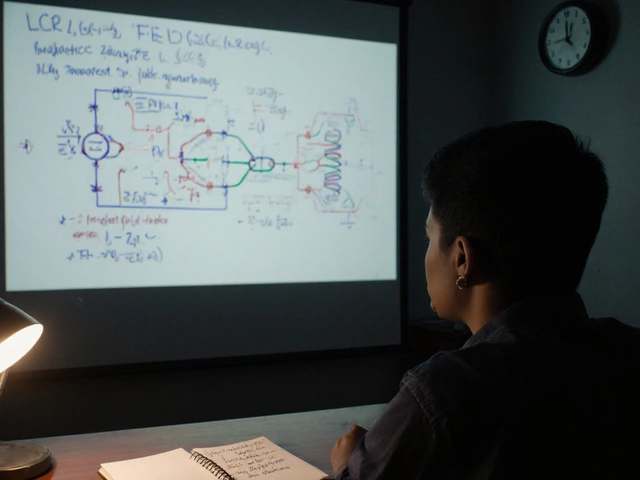Think every MBA program is two years long? Not quite. How long it takes to finish your MBA depends on the path you pick—and life can throw in some surprises too. It’s one of the first things people want to know: how much of your life are you signing up for?
The classic full-time MBA is the big, bold route—think two years, jammed with classes, group projects, and networking. But plenty of people can’t hit pause on their careers or take a school break. That’s where part-time, executive, and online MBAs come in. These can stretch out for three years or more—or move faster if you load up on classes.
Program length isn’t just about the school calendar. Your work, family, and energy levels all factor in. Picking the “best” timeline really comes down to what plays nice with your world right now.
- Classic Full-Time MBA: The Standard Track
- Flexible Part-Time and Online Options
- Speeding Up or Slowing Down Your MBA
- Tips for Surviving the Grind
Classic Full-Time MBA: The Standard Track
If you picture hitting the books, quitting your job, and diving in headfirst, you’re thinking of a full-time MBA. This is the “standard” route at most business schools—like Harvard, Wharton, or Stanford. Most full-time MBAs take about 21 to 24 months, or two academic years including summer internships. You're on campus, networking, and living the business school grind 24/7.
Every school sets its pace, but here’s what a typical full-time MBA timeline looks like:
- MBA duration: 21–24 months for a traditional full-time program
- Core courses in the first year (finance, marketing, leadership, accounting)
- Summer internship, right in the middle, to test the waters and build your resume
- Electives and specialization in the second year, where you carve out your niche
- Capstone projects, global trips, or consulting assignments (these have become big drawcards lately)
Check out the data on well-known programs and their timelines:
| Business School | Standard Full-Time MBA Length |
|---|---|
| Harvard Business School | 24 months |
| Wharton (Penn) | 20 months |
| INSEAD | 10–12 months (intensive pace) |
| Stanford GSB | 24 months |
Not all programs run two years. INSEAD’s one-year program is fast, but super intense—no long breaks, no big breathers. Still, most top U.S. programs stick to the classic two-year calendar so students can do internships and explore career pivots without rushing. If you want a real campus feel and time to reflect (or maybe travel), this is your lane.
Tip: Many recruiters and companies like hiring from traditional full-time MBA program length because it shows dedication and offers you the luxury to really grow your network.
Flexible Part-Time and Online Options
If you’re working full-time or juggling family stuff, a traditional MBA program can feel out of reach. Good thing there are flexible routes now, and you don’t have to quit your job or move cities just to get that degree. Part-time and online MBAs are built for real life.
Part-time programs usually take about three years to finish, but some people stretch them up to five years if life gets busy. You go to classes in the evenings, on weekends, or even just a few weekends a month. Some well-known schools like NYU Stern and Chicago Booth offer popular part-time programs where you can take as few or as many courses as your schedule allows.
Online MBAs can be even more self-paced. Schools like Indiana University’s Kelley School of Business and the University of North Carolina’s Kenan-Flagler have online MBAs designed for working adults. Some programs let you speed ahead and finish in 18 months, while others let you take your sweet time and walk the stage up to five years later. The key is that you plan your own pace, so if you want to double up on classes for a semester when things at work slow down, you can. Or if you need to take a break, no one’s stopping you.
One important fact: most MBA program length decisions depend on personal stuff—how many credits you can handle each term, and how much time you can carve out for school. Program websites usually show minimum and maximum completion times, so check those before jumping in.
Here’s what to think about if you’re going flexible:
- Some employers pay for part-time or online MBAs—ask if tuition help is on the table.
- Online doesn’t always mean “easy”—the workload can still be heavy, and you’ll need to stay organized.
- Networking is different online, but still possible through group projects, virtual events, and local meetups.
- Application deadlines and start dates tend to pop up throughout the year, not just in the fall.
The bottom line: The flexible approach can fuse neatly with a busy life, and you’re not locked into one timeline. It’s about making your MBA work for you, not the other way around.

Speeding Up or Slowing Down Your MBA
Here’s a wild fact: you don’t have to stick to the “average” time most people spend on their MBA. There’s way more flexibility than you might think. The path you take has a big impact on how fast you finish. Some folks sprint through in a year, while others take five years or longer—especially if life gets messy or work needs more attention.
If you want the fastest route, check out accelerated programs. They’re often 12 to 18 months, packed tight with summer classes or heavy course loads. Harvard, Kellogg, and INSEAD are just a few big names with these turbo-charged options. But the schedule is brutal—you’ll barely come up for air. Perfect if you want to get back to work ASAP or don’t mind missing out on long internships.
Part-time and online paths open up the slow lane. You can pace yourself based on job demands, family stuff, or just needing a break. A lot of schools actually let you switch between full-time and part-time if things suddenly get busy or slow down. Here’s a quick look at timelines:
| Program Type | Typical Length |
|---|---|
| Accelerated Full-Time MBA | 12-18 months |
| Standard Full-Time MBA | 20-24 months |
| Part-Time MBA | 30-60 months |
| Online MBA | 24-60 months |
Sometimes life just gets in the way—work projects explode, or personal stuff slows you down. Most business schools get that. They usually offer options like course deferrals, taking semesters off, or going at your own pace. Northwestern Kellogg even lets you take up to five years to finish their part-time program.
“The reality is that everyone’s career and life needs are different. Flexibility is key, which is why our part-time and online programs stretch up to five years if needed.” — Kellogg School of Management
If you’re eyeing a way to stack classes and wrap up faster, make sure you’re clear on the rules. Schools often cap how many credits you can take at once. Some let you count work experience or previous coursework toward graduation, which can cut a semester or two off your timeline. But don’t rush just to finish faster. The value isn’t just about the diploma—it’s also about what you actually learn and who you meet.
- Check each school’s flexibility on time to completion before you commit.
- Ask if internships or projects can count as credits—that sometimes speeds things up.
- Find support groups or study partners to keep you on track if you choose the slow lane.
One more tip—if you want to maximize your MBA duration, talk to current students or alumni. They’ll give you the real scoop on what’s doable and what’s not. Nobody’s journey is the same, so find the pace that works for you.
Tips for Surviving the Grind
Juggling classes, homework, projects, and possibly a full-time job? Yeah, getting through your MBA program length is no small feat. The good news: lots of grads have made it out the other side—and you can too. Here’s how to avoid burning out and actually enjoy the process (most days, anyway).
- Use your calendar like a pro: Block out study time, deadlines, and group meetings. Even 30-minute study sprints add up, so treat them as non-negotiable.
- Don’t be shy—ask for help: Instructors and classmates have been where you are. Most schools offer tutoring, study groups, or even free workshops for tough subjects.
- Set boundaries early: Family time? Stick to it. Work emails? Check them after class. The clearer you are with others, the less you’ll be interrupted.
- Join the right crew: MBA students with a solid support group or study buddy report higher success. Networking isn’t just for job hunting—it saves your sanity in tough semesters.
- Prioritize your health: The MBA grind tempts you to skip meals, workouts, and sleep. Don’t fall for it. Just 20 minutes of daily movement can boost brainpower and energy.
How do people actually manage the crazy workload? Here’s what a 2024 GMAC report found about MBA students balancing it all:
| Habit | Percent Reporting Success |
|---|---|
| Using a planner or digital calendar | 78% |
| Regular exercise (3+ times/week) | 65% |
| Active peer support/group study | 57% |
| Setting tech-free hours | 44% |
| Professional counseling/coaching | 18% |
Finally, keep an eye on burnout. If you’re feeling totally wiped for more than two weeks, talk to a mentor or check in with your school’s support services. Sometimes, just mixing up your schedule or finding a new study spot gives you a second wind. No one expects you to grind nonstop—so don’t expect it from yourself.





